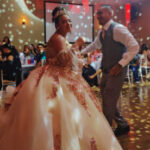Lucy Ashe’s “Clara & Olivia” transports readers to the dazzling yet demanding world of 1930s London ballet. We meet nineteen-year-old twins, Clara and Olivia, members of the corps de ballet at Sadler’s Wells, poised on the brink of significant life changes. Olivia, reserved and dedicated, dreams of becoming a prima ballerina through diligent practice. In contrast, the vivacious and adventurous Clara yearns for a stardom that extends beyond the ballet stage, embracing London’s nightlife.
Despite their contrasting personalities and Olivia’s insecurities about measuring up to her sister, the twins share a deep bond. They live together, share clothes, and provide mutual support, navigating life without the presence of their mother, who is in a mental hospital.
Clara is romantically involved with Nathan Howell, a pianist and former child prodigy, but she finds his serious intellectual nature increasingly tiresome and resists commitment. Meanwhile, Olivia attracts the attention of Samuel Steward, a quiet apprentice shoemaker who delivers pointe shoes to the theatre and harbours aspirations of becoming a clothing designer.
The narrative hints at a looming obsession from either Nathan or Samuel that will cross boundaries, leaving readers eager to uncover who takes it too far and the ensuing consequences within the pages of this compelling book.
Immersed in the Passion of Dance and Theatre
“Clara & Olivia” immediately captivated me. As a reader drawn to stories where characters are deeply passionate and exceptionally talented in artistic disciplines, dedicating their lives to their craft, this novel instantly resonated. The book beautifully ticks the box for anyone fascinated by the dedication and artistry within demanding performance worlds.
From the outset, I felt completely drawn into not just the twins’ personal lives but also the broader, intricate world of theatre. Ashe’s writing is mesmerizing, making it easy to lose oneself for hours, turning pages without noticing time passing. This immersive quality intensifies in the final third of the book as tensions rise and the narrative becomes increasingly gripping.
Authenticity Rooted in Ballet Expertise
It came as no surprise to learn that the author herself is a trained ballerina. The novel’s rich detail regarding dancers’ routines – encompassing both their intricate movements and daily lives – the rigorous expectations placed upon ballerinas, and the prominent figures of the era, when British ballet was forging its identity, all speak to an insider’s knowledge. A delightful touch was the appearance of ballet critic Arnold Haskell, a figure familiar to those studying ballet history.
Ashe skillfully grounds the story in its historical context in multiple ways. We learn about the wartime experiences of the twins’ father and Samuel’s father during World War I. The anecdote of Clara and Olivia’s father spending their first six months with them due to an injury sustained at the Front becomes a poignant family story. Conversely, Samuel’s father is depicted as a cruel bully, his personality warped by his wartime experiences. The depiction of the hospital where the twins’ mother resides also reflects the realities and attitudes of the time.
The Complex Bond Between Sisters
The dynamic between Clara and Olivia is both intricate and compelling. Initially, Olivia seems critical of Clara’s carefree attitude and envious of her charisma and relationship with Nathan, while Clara worries about Olivia’s lack of spontaneity. As the story progresses, they begin to withhold crucial information from each other, adding layers to their relationship.
However, observing their interactions reveals the profound love and closeness they share. It becomes evident that Clara, with her stronger personality, shields Olivia from their mother’s unhealthy influence. In the absence of other significant family ties, they depend entirely on each other, consistently providing unwavering support.
A shared insecurity plagues both sisters: the fear that each is considered the more talented dancer, and the notion that their novelty as identical twins in ballet might diminish their individual value if one were to leave.
Ashe also raises a fascinating point: we often subject ourselves to harsh self-criticism that we would never direct towards others. For identical twins, this internal negativity takes on another dimension – how can one critique their own appearance without inadvertently hurting their sibling, who shares the same face?
Appearance vs. Reality in the Ballet World
A central theme explored in “Clara & Olivia” is the dichotomy between appearance and reality. The exhilarating performances before appreciative audiences, the glamorous cultural events and vibrant nights Clara experiences, and the opportunities that arise for the twins all create a captivating surface.
Yet, Ashe never allows the reader to forget the demanding and often brutal nature of ballet. The physical pain, the relentless discipline, and the limited window of opportunity to achieve success before injury or age intervene are starkly portrayed.
Similarly, both Nathan and Samuel become fixated on the idealized image they project onto their chosen twin – an image of physical perfection and conformity to the corps de ballet’s expectations. They are disconcerted when the sisters reveal their messy, human realities and independent minds. One suitor emerges from this experience disillusioned but wiser, while the other intensifies his attempts to mold “his” twin into his desired image.
“Clara & Olivia” is an immersive, thrilling, and thoroughly captivating novel that will resonate with anyone drawn to stories of passion, artistry, and the complexities of human relationships within a vividly realized historical setting.

